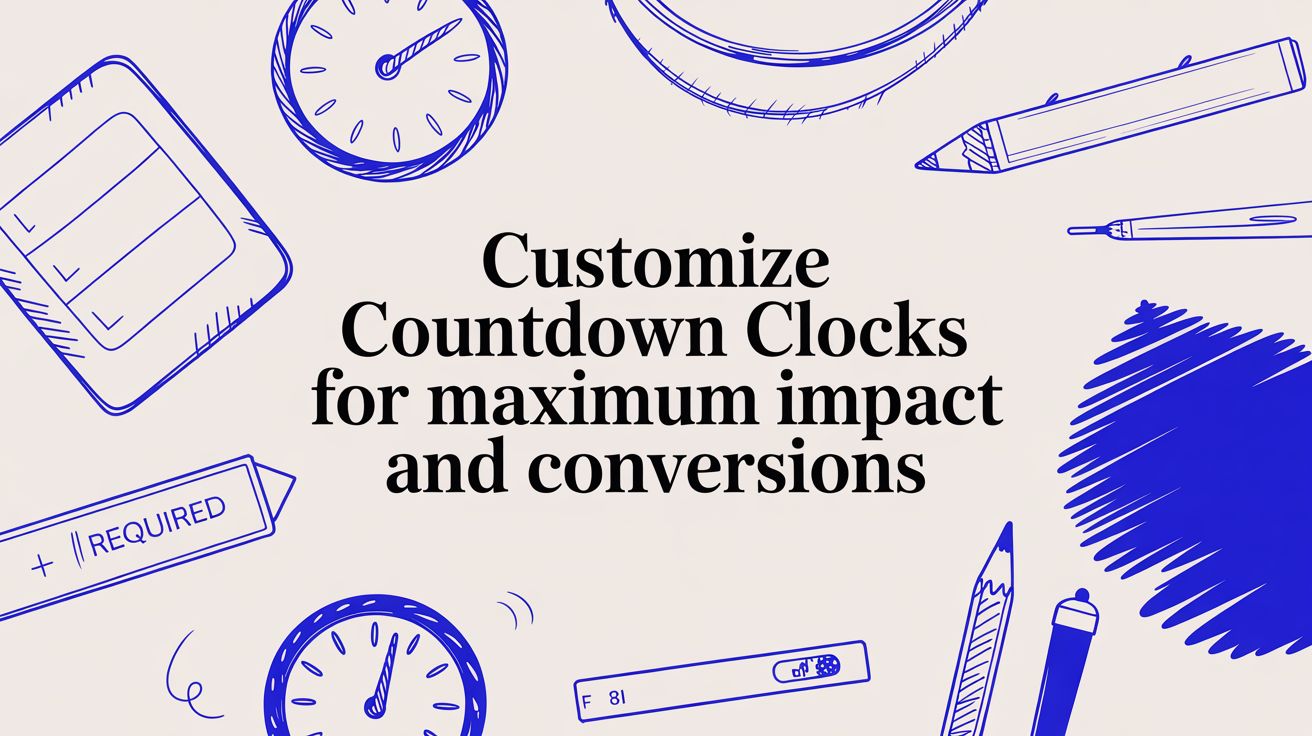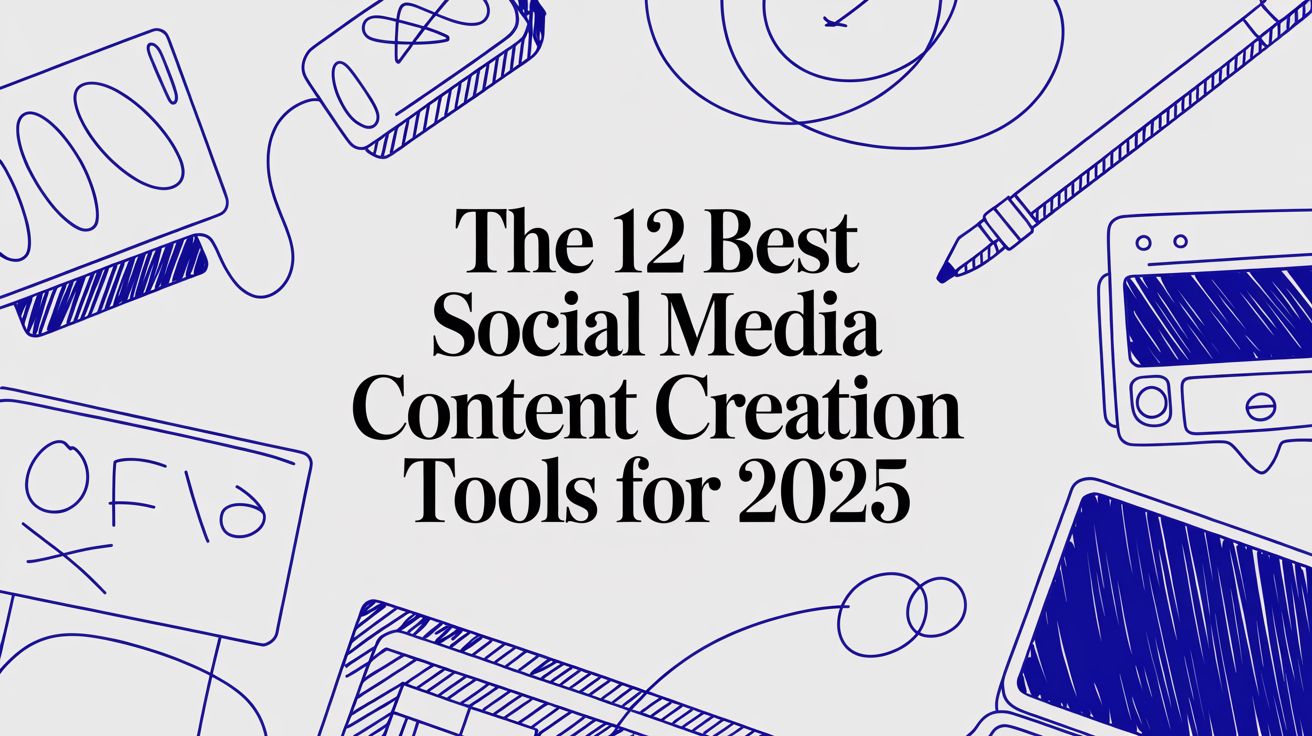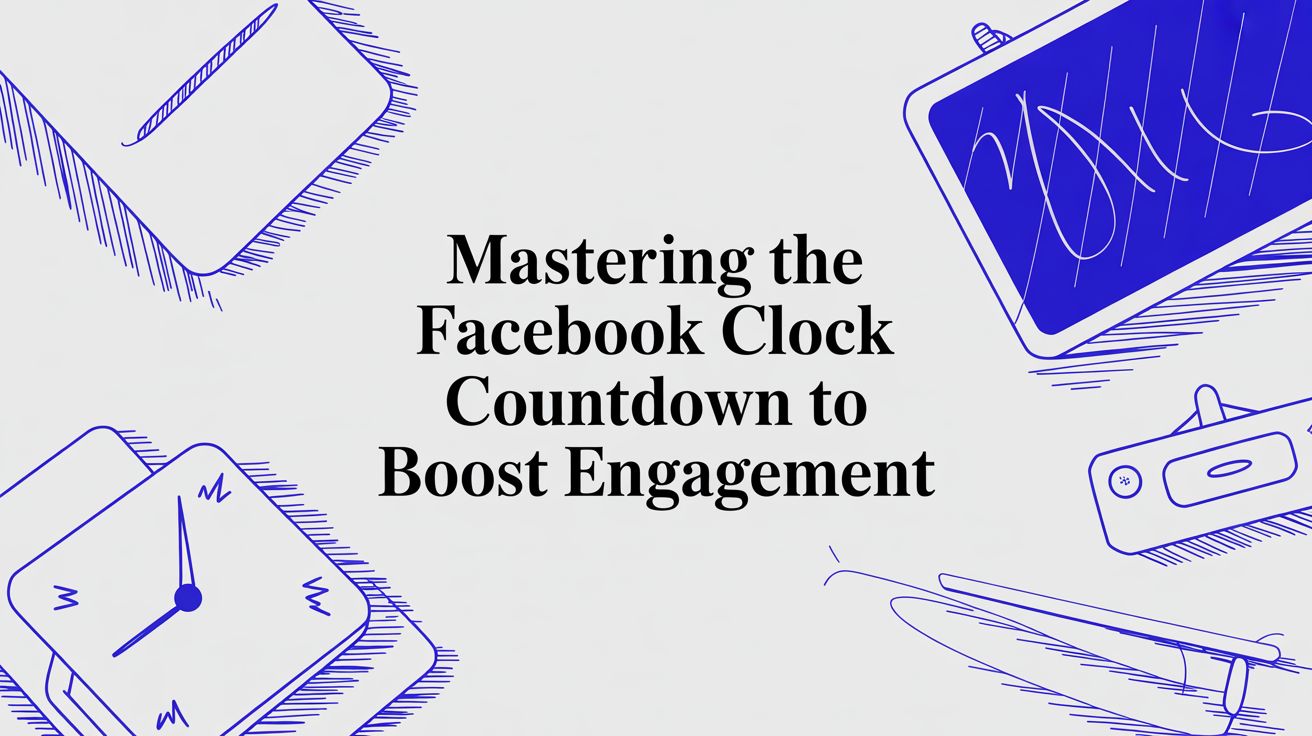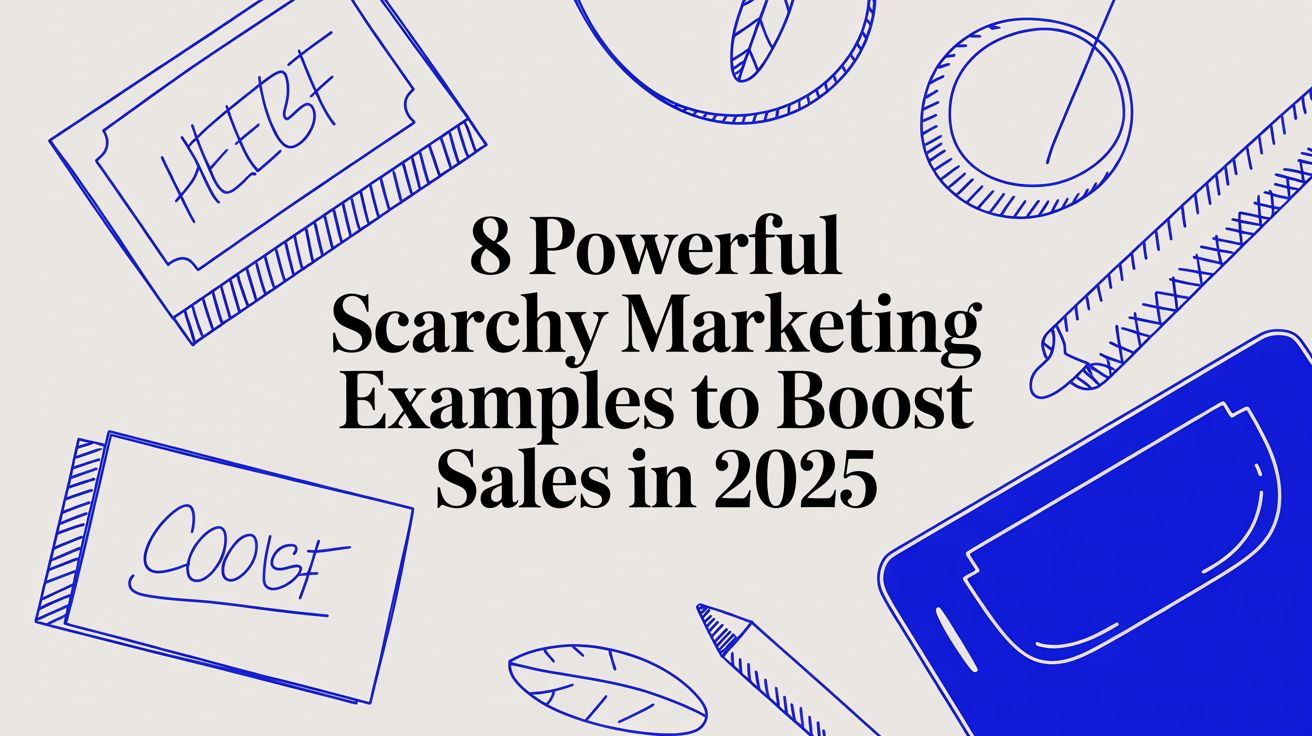10 Actionable Black Friday Marketing Tips for 2025
Unlock success with our top 10 Black Friday marketing tips for 2025. Discover expert strategies to boost sales, engagement, and ROI this holiday season.
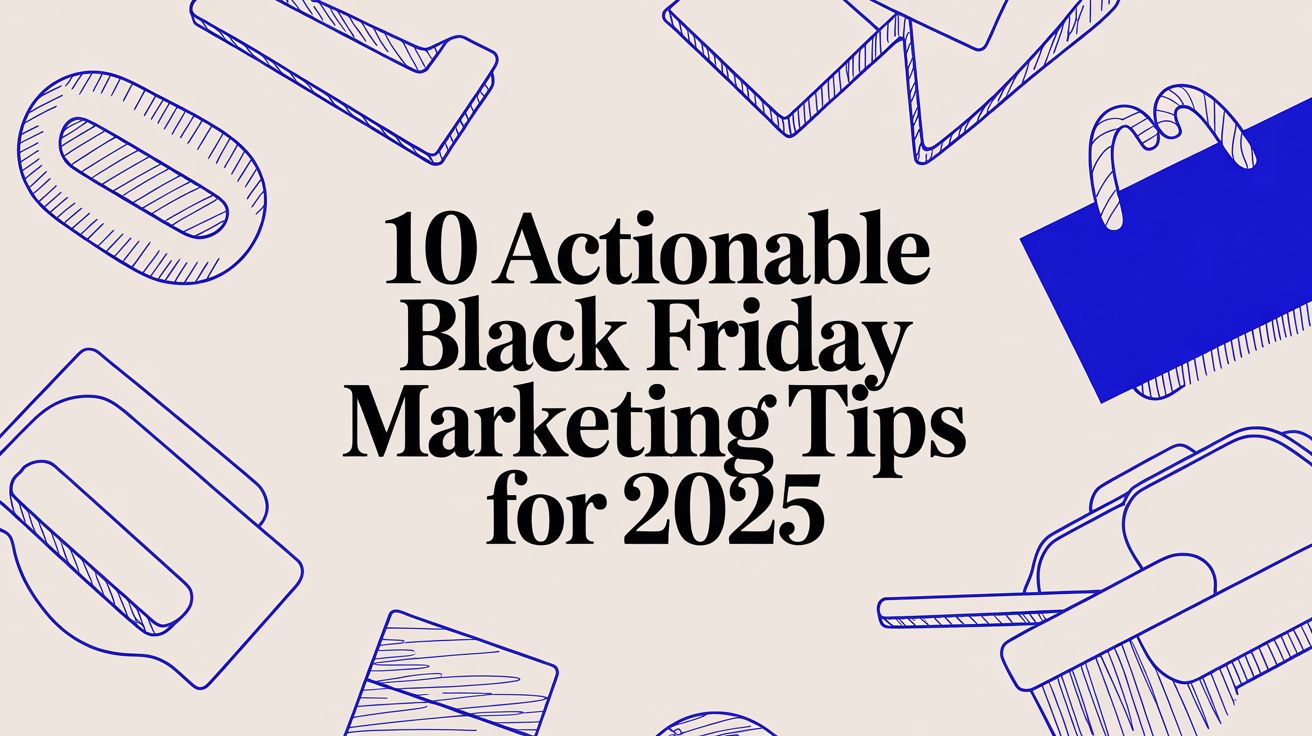
Black Friday is no longer a single-day sprint; it's a marathon of strategic planning, customer engagement, and flawless execution. For e-commerce brands, this period represents the single biggest opportunity of the year to drive revenue, acquire new customers, and build lasting loyalty. In a crowded marketplace, however, generic advice simply won't cut it. You need a data-driven, actionable playbook that transforms casual browsers into devoted buyers.
This guide provides 10 powerful Black Friday marketing tips designed for immediate impact. We will move beyond the basics, offering fresh perspectives on everything from building pre-launch hype with countdown timers to optimizing the mobile checkout experience. Each strategy is crafted to help you not just compete, but dominate the upcoming holiday shopping season.
We'll skip the high-level theory and dive straight into specific, tactical advice. You will learn how to segment your audience for hyper-personalized offers, integrate your marketing channels for a seamless customer journey, and leverage scarcity to drive urgent action. Whether you're a small business owner or a marketing manager at a growing brand, these insights will equip you with the tools needed to craft your most successful Black Friday and Cyber Monday campaign yet.
1. Early Planning and Strategy Development
The most successful Black Friday campaigns aren’t born from last-minute scrambles; they are the result of meticulous, early-stage planning. Starting your strategy development at least 2-3 months in advance is a cornerstone of effective Black Friday marketing tips. This lead time allows you to move beyond reactive tactics and build a proactive, integrated campaign that aligns your marketing, inventory, and sales goals. Major retailers like Amazon and Target begin their planning as early as July and August to ensure every component, from supply chain to ad creative, is perfectly synchronized.
This foundational step ensures your team has ample time to conduct market research, segment audiences, and define clear Key Performance Indicators (KPIs). By avoiding the pressure of eleventh-hour decisions, you can allocate your budget more effectively, negotiate better terms with partners, and create higher-quality content that resonates with your customers.
Actionable Implementation Steps
- Create a Master Timeline (August): Develop a detailed project timeline with specific deadlines for creative development, ad campaign setup, email scheduling, and inventory checks.
- Conduct Competitive Analysis (September): Research what your competitors did last year. Analyze their offers, messaging, and channels to identify opportunities and potential threats.
- Establish Clear KPIs Early: Define what success looks like. Is it revenue, new customer acquisition, or average order value? Set measurable goals to track performance.
- Schedule Regular Strategy Reviews: Hold bi-weekly meetings to review progress, adapt to market changes, and ensure all teams remain aligned on the campaign objectives.
2. Teaser Campaigns and Countdown Marketing
Building anticipation before the main event is one of the most effective Black Friday marketing tips to break through the noise. Instead of waiting for Black Friday week, launch teaser campaigns to generate excitement and keep your brand top-of-mind. This strategy extends your marketing window and transforms a single-day sale into a multi-week event, capitalizing on consumer excitement and creating a loyal, engaged audience ready to purchase the moment your deals go live. Brands like Best Buy and Sephora master this by releasing early deal previews and offering exclusive presale access to loyalty members.
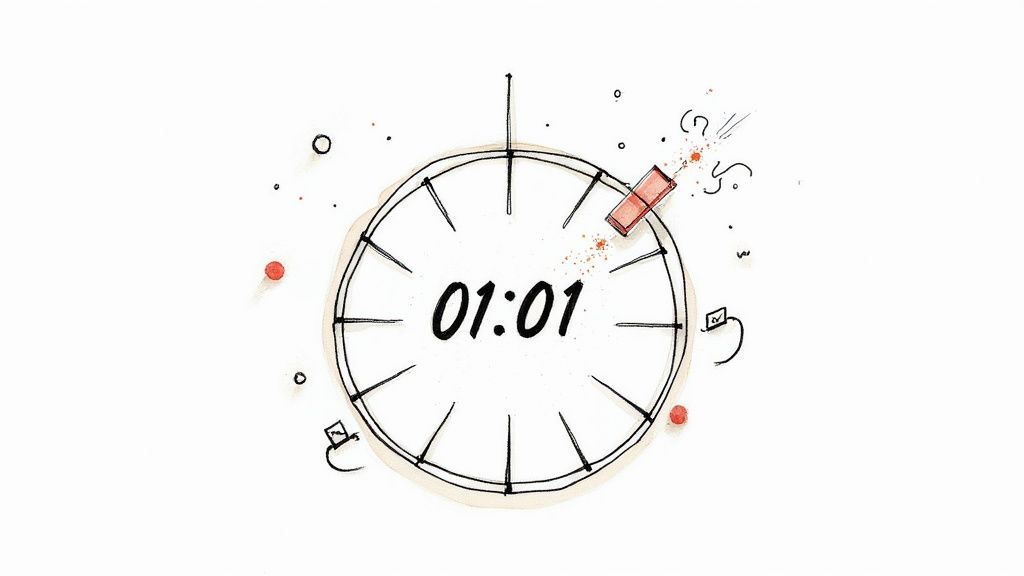
This approach leverages the psychological power of anticipation and the fear of missing out (FOMO). By gradually revealing offers and using countdown timers, you create a sense of urgency that drives email sign-ups and social media follows. This ensures that when your main sale begins, you have a primed audience eager to convert. For more insights on leveraging this tactic, see how to build the perfect Black Friday countdown campaign.
Actionable Implementation Steps
- Launch Teasers 3-4 Weeks Early: Start dropping hints on social media and to your email subscribers about your upcoming deals to build initial buzz.
- Integrate Countdown Timers: Use tools like a countdown timer app on your website's homepage, product pages, and in emails to create a powerful visual reminder of the approaching sale.
- Reveal Deals Gradually: Don't show all your cards at once. Unveil a new deal category or a hero product each week to maintain momentum and keep your audience coming back.
- Create Exclusive Sneak Peeks: Offer your most loyal customers, such as email subscribers or loyalty program members, a first look at the deals to reward them and encourage immediate conversions.
3. Personalization and Segmentation
Generic, one-size-fits-all promotions no longer cut it in a crowded marketplace. One of the most powerful Black Friday marketing tips is to leverage customer data for deep personalization and audience segmentation. This strategy involves dividing your audience into distinct groups based on demographics, purchase history, and browsing behavior, then delivering tailored messages and offers that resonate with each segment's specific needs and interests. Giants like Amazon attribute over 35% of their revenue to their recommendation engine, a testament to the power of showing customers exactly what they want to see.
This targeted approach makes customers feel understood rather than just marketed to, significantly boosting engagement and conversion rates. When a VIP customer receives an exclusive early access offer and a new visitor sees a welcome discount on products they just viewed, the experience becomes relevant and compelling. By moving beyond mass communication, you create a more meaningful connection that drives both immediate sales and long-term loyalty.
Actionable Implementation Steps
- Create Key Audience Segments: Start by building at least five core segments. These could include VIPs (high-spenders), recent purchasers, cart abandoners, first-time visitors, and customers who bought specific product categories last year.
- Leverage Purchase History: Analyze past transaction data to predict future interests. If a customer bought a coffee machine last Black Friday, offer them a deal on premium coffee beans or accessories this year.
- Implement Dynamic Content: Use tools that can change your website’s banners, product recommendations, and pop-ups based on who is visiting. A returning customer should see a different homepage than a new one.
- Test Segment-Specific Offers: Don't send the same discount to everyone. A/B test different offers for different segments to see what resonates most. For example, test a percentage-off deal for new customers versus a free gift for loyal ones.
4. Multi-Channel Marketing Integration
A siloed Black Friday campaign is a missed opportunity. To maximize impact, you need to coordinate your efforts across email, social media, SMS, and paid advertising to create a seamless and unified customer journey. This approach ensures that your message is consistent and reinforced at every touchpoint, whether a customer sees a Facebook ad, opens an email, or receives a text alert. Retail giants like Macy's and ASOS excel at this, running synchronized promotions across their websites, apps, and social feeds to create an omnipresent brand experience.
This holistic strategy is one of the most effective Black Friday marketing tips because it meets customers where they are. A cornerstone of successful holiday campaigns, understanding what multi-channel marketing explained entails is vital for building trust and driving conversions. By presenting a cohesive front, you guide customers smoothly from awareness to purchase, increasing the likelihood they will act on your offers.
Actionable Implementation Steps
- Create a Cross-Channel Content Calendar: Map out your messaging, offers, and posting times for each channel (email, social, SMS, etc.) to ensure consistency and prevent audience fatigue.
- Maintain Consistent Branding and Messaging: Use the same visual elements, headlines, and call-to-actions across all platforms to create a recognizable and trustworthy campaign identity.
- Implement UTM Parameters for Tracking: Use unique UTM codes for each channel and campaign to accurately track which touchpoints are driving the most traffic and conversions in your analytics.
- Coordinate Email, SMS, and Social Posts: Schedule your communications to launch simultaneously or in a logical sequence. For example, an email blast announcing a deal can be followed by a reminder SMS and a social media post an hour later.
5. Mobile-First Optimization
In today's retail landscape, a mobile-first approach is no longer an option; it's a necessity. With a significant portion of holiday shopping traffic originating from smartphones, neglecting the mobile experience is one of the costliest mistakes a brand can make. This strategy involves designing your website, emails, and ads for mobile devices first, and then adapting them for desktop, ensuring a seamless journey for the majority of your audience. For instance, Shopify consistently reports that over two-thirds of Black Friday orders are made on mobile, while retail giants like Target see their app drive a massive share of digital sales.
Prioritizing mobile optimization is a crucial Black Friday marketing tip because it directly impacts conversion rates. A slow, clunky mobile site leads to high bounce rates and abandoned carts, whereas a streamlined experience with features like one-click purchasing, as perfected by Amazon, captures impulse buys and reduces friction. This focus ensures you are meeting customers where they are, providing a convenient and efficient path to purchase that aligns with modern shopping habits.
Actionable Implementation Steps
- Test Your Site Speed: Use tools like Google PageSpeed Insights to test your site's performance on 3G and 4G networks. Aim for a load time of under three seconds to retain visitor attention.
- Simplify the Checkout Process: Minimize the number of form fields required for purchase. Implement mobile-friendly payment options like Apple Pay, Google Pay, and PayPal to accelerate transactions.
- Enhance User Interface (UI): Ensure all buttons and clickable elements are large and "thumb-friendly" with adequate spacing to prevent accidental taps. Use a clean, uncluttered layout with readable fonts.
- Leverage Mobile-Specific Offers: Create exclusive flash sales or discounts accessible only through your mobile app or mobile site. Use push notifications to announce these deals and drive immediate engagement.
6. Limited-Time Offers and Scarcity Marketing
The psychology of scarcity is a powerful driver of consumer behavior, making it one of the most effective Black Friday marketing tips. By creating genuine urgency through limited stock, time-sensitive deals, and exclusive offers, you can significantly accelerate the customer’s journey from consideration to purchase. This tactic taps into the fear of missing out (FOMO), encouraging shoppers to act immediately rather than risk losing a great deal. Brands like Newegg master this with hourly "Doorbuster" deals that have limited quantities, while H&M uses "Online Exclusive" tags with visible stock indicators to prompt quick decisions.
Implementing scarcity authentically is key to building trust and avoiding customer frustration. Your offers should be based on real inventory levels and concrete timelines, not artificial pressure. When executed transparently, this strategy not only boosts short-term sales but also enhances the perceived value of your products, making your Black Friday event feel like an exclusive opportunity.
Actionable Implementation Steps
- Integrate Countdown Timers: Use countdown timers on your product pages, landing pages, and email campaigns to visually represent the urgency of a deal. They are a constant reminder that time is running out. Learn more about how to make timers for your promotions.
- Display Real-Time Stock Levels: Show customers exactly how many items are left in stock (e.g., "Only 5 left!"). This transparency provides social proof and genuine scarcity, encouraging faster checkouts.
- Create Tiered, Time-Based Offers: Structure your sale with deals that change over the Black Friday weekend. For example, offer a 40% discount for the first 12 hours, then 30% for the next 24, creating multiple peaks of urgency.
- Launch Flash Sales for Specific Products: Announce short-term, deep discounts on popular items via email or social media. This drives immediate traffic and rewards your most engaged followers.
7. Customer Email List Building and Pre-Campaign Signup
Your email list is one of your most valuable assets, especially during the competitive Black Friday season. Focusing on building an engaged subscriber base well before the event allows you to bypass the noise of social media and communicate directly with interested customers. A pre-campaign signup strategy is a powerful way to capture high-intent leads who have explicitly opted in for your deals, turning cold traffic into a warm, receptive audience. Brands like J.Crew and Uniqlo master this by offering exclusive incentives, such as "VIP early access" or a first-purchase discount, in exchange for an email address.
This proactive approach builds a direct line of communication, allowing you to nurture leads with sneak peeks and personalized content leading up to the sale. By securing their permission to market to them, you ensure your carefully crafted offers land in their inbox, not lost in an algorithm. This tactic is one of the most effective black friday marketing tips for driving direct conversions and building long-term customer relationships beyond the holiday rush.
Actionable Implementation Steps
- Create a Dedicated Signup Landing Page: Design a clean, compelling landing page that clearly outlines the benefits of joining your VIP list (e.g., early access, exclusive discounts).
- Implement Smart Pop-ups: Use exit-intent and time-based pop-ups on your website to capture visitors' attention with an irresistible signup offer before they leave.
- Offer an Immediate Incentive: Provide instant gratification with a welcome email that delivers a 10-15% discount code or free shipping offer upon signup.
- Segment Your New Subscribers: Immediately categorize new signups based on how they joined your list or their expressed interests to enable targeted email sequences later. Explore more on how this integrates into broader Black Friday marketing strategies.
8. Social Media Strategy and User-Generated Content
A dynamic social media presence is indispensable for a modern Black Friday campaign, but its true power is unlocked when combined with authentic user-generated content (UGC). This strategy involves leveraging paid ads, influencer partnerships, and organic content to amplify reach while simultaneously encouraging customers to share their own experiences with your brand. This blend builds a powerful sense of community and trust that traditional advertising simply cannot replicate. For example, Glossier’s campaigns encouraging UGC have generated tens of thousands of authentic customer posts, creating a massive library of social proof.
This approach turns your audience from passive viewers into active brand advocates. By featuring genuine customer photos and videos, you validate purchasing decisions for potential buyers and create a feedback loop that strengthens brand loyalty. A well-executed UGC plan is one of the most cost-effective yet impactful Black Friday marketing tips available, as it leverages the credibility of real people to drive conversions.
Actionable Implementation Steps
- Launch a Hashtag Campaign: Create a unique, memorable hashtag for your Black Friday event (e.g., #BrandNameHaul) and encourage customers to share their purchases for a chance to be featured or win a prize.
- Partner with Micro-Influencers: Collaborate with influencers who have 10K-100K followers. Their smaller, more engaged audiences often provide higher authenticity and ROI compared to macro-influencers.
- Host Live Shopping Events: Use platforms like Instagram Live or TikTok Live to host real-time shopping events. Showcase products, answer questions, and offer exclusive flash deals to viewers to drive immediate sales.
- Repost Customer Content: Actively monitor brand mentions and hashtags. When you find high-quality UGC, request permission from the creator and repost it to your brand’s official channels, always giving proper credit.
9. Retargeting and Abandoned Cart Recovery
During the high-traffic chaos of Black Friday, a significant number of shoppers will browse, add items to their cart, and leave without completing a purchase. A robust retargeting and abandoned cart recovery strategy is essential for re-engaging these high-intent prospects and converting what would otherwise be lost revenue. This approach uses targeted ads and automated emails to remind customers of the products they considered, often with an added incentive to finalize their purchase. Amazon, for example, excels at this by displaying previously viewed items across its network, while Zappos has been known to recover a significant portion of lost sales through timely email reminders.
This tactic is one of the most effective Black Friday marketing tips because it focuses on a warm audience that has already demonstrated interest. A major challenge during sales events is cart abandonment; implementing proven strategies to reduce shopping cart abandonment is crucial for maximizing your sales potential. By recapturing their attention, you can guide them back to your site to complete the checkout process, boosting your overall conversion rate.
Actionable Implementation Steps
- Set Up an Automated Email Sequence: Create a three-part email series. Send the first reminder within one hour, a follow-up at 24 hours, and a final email at 72 hours, potentially with a small, exclusive discount to create urgency.
- Implement Dynamic Retargeting Ads: Use platforms like Facebook and Google to launch dynamic ad campaigns that show shoppers the exact products they left in their cart. This hyper-personalization is highly effective.
- Personalize Your Messaging: Go beyond "You left something behind." Use the customer's name and include high-quality images of the abandoned items directly in the email or ad creative.
- A/B Test Your Subject Lines and Offers: Continuously test different email subject lines (e.g., "Did you forget something?" vs. "Your Black Friday items are waiting!") and discount amounts to see what resonates best with your audience.
10. Analytics, Testing, and Performance Optimization
A data-driven approach is non-negotiable for maximizing Black Friday ROI. Instead of a "set it and forget it" mindset, the most effective marketers continuously monitor campaign performance, test different elements, and optimize their strategy based on real-time data. This agility allows you to identify what's working and pivot away from underperforming tactics during the high-stakes shopping period. Companies like Etsy, known for running hundreds of tests simultaneously during peak seasons, leverage this process to refine everything from homepage layouts to checkout flows for maximum conversion.
This iterative process transforms your campaign from a static plan into a dynamic, responsive machine. By tracking key metrics and acting on the insights they provide, you can make informed decisions that directly boost sales, improve customer acquisition cost, and enhance the overall effectiveness of your Black Friday marketing tips. Without this analytical rigor, you're essentially flying blind and leaving money on the table.
Actionable Implementation Steps
- Set Up a Real-Time Dashboard: Before the sales period begins, create a centralized dashboard in Google Analytics or a similar tool to monitor key metrics like conversion rate, Average Order Value (AOV), Customer Acquisition Cost (CAC), and ROAS.
- A/B Test One Element at a Time: Isolate single variables for testing, such as an email subject line, a CTA button color, or a specific ad creative. This ensures you can accurately attribute performance changes.
- Implement UTM Parameters: Use UTM codes for all your campaign links (social media, emails, ads) to precisely track which channels are driving the most valuable traffic and conversions.
- Prepare a Rapid-Response Team: Designate a small team to monitor analytics and make quick optimizations. They should be empowered to pause underperforming ads or adjust bids without lengthy approval processes.
10-Point Black Friday Marketing Comparison
| Item | 🔄 Implementation complexity | ⚡ Resource requirements | 📊⭐ Expected outcomes | 💡 Ideal use cases | ⭐ Key advantages | |---|---:|---:|---|---|---| | Early Planning and Strategy Development | 🔄 Medium–High — cross-team coordination, upfront time | ⚡ Moderate — planning meetings, analytics, timeline management | 📊⭐ Higher ROI, smoother execution, fewer last-minute errors | 💡 Enterprise retailers, multi-channel campaigns, inventory-heavy sellers | ⭐ Coordinated campaigns, better forecasting, competitive positioning | | Teaser Campaigns and Countdown Marketing | 🔄 Low–Medium — content cadence and timing | ⚡ Moderate — creative assets, timers, email sequences | 📊⭐ Increased engagement, earlier traffic, extended sales window | 💡 Consumer brands seeking buzz, product launches, loyalty programs | ⭐ Builds anticipation, drives signups, extends reach | | Personalization and Segmentation | 🔄 High — data architecture, segmentation logic | ⚡ High — CRM/CDP, analytics, AI tools | 📊⭐ Significant conversion lift (10–30%), improved retention | 💡 Brands with rich customer data, subscriptions, high AOV products | ⭐ Highly relevant messaging, reduced spend waste, stronger loyalty | | Multi-Channel Marketing Integration | 🔄 High — complex cross-channel coordination | ⚡ High — content, ad spend, orchestration tools, team | 📊⭐ Better campaign effectiveness (≈20–40%), broader reach | 💡 Omnichannel retailers, brands with online + offline presence | ⭐ Cohesive brand experience, improved retargeting, unified insights | | Mobile-First Optimization | 🔄 Medium — responsive design and performance testing | ⚡ Moderate–High — developers, QA, performance tooling | 📊⭐ Higher mobile conversions, lower bounce, SEO benefits | 💡 Mobile-heavy traffic stores, app-driven brands | ⭐ Captures majority traffic, faster checkout, higher conversion | | Limited-Time Offers and Scarcity Marketing | 🔄 Low–Medium — timing, inventory sync, transparency | ⚡ Moderate — inventory controls, timers, support | 📊⭐ Conversion spikes, traffic surges, inventory clearance | 💡 Clearance sales, product launches, urgency-driven promos | ⭐ Urgency-driven conversions, media attention, fast sales | | Customer Email List Building and Pre-Campaign Signup | 🔄 Low — landing pages and signup flows | ⚡ Moderate — lead magnets, email platform, copywriting | 📊⭐ High ROI channel, strong Black Friday engagement | 💡 DTC brands, SMB retailers, subscription services | ⭐ Direct audience access, cost-effective reach, high ROI | | Social Media Strategy and User-Generated Content | 🔄 Medium — platform-specific content and influencer ops | ⚡ Moderate — content creation, influencer fees, ad budget | 📊⭐ Broad reach, high engagement, trust via UGC | 💡 Lifestyle/visual brands, community-driven products | ⭐ Authenticity, scalable reach, social commerce opportunities | | Retargeting and Abandoned Cart Recovery | 🔄 Medium–High — tracking, dynamic creatives, cadence | ⚡ Moderate — ad spend, automation, tracking pixels | 📊⭐ Recovers 10–30% of carts, strong recovery ROI | 💡 E‑commerce stores with high abandonment rates | ⭐ Recovers lost sales, lowers CAC, targeted re-engagement | | Analytics, Testing, and Performance Optimization | 🔄 High — analytics stack, experimentation rig | ⚡ High — tools, analysts, A/B testing platforms | 📊⭐ Improved ROI, rapid identification of winners, continual optimization | 💡 Data-driven teams, large/complex campaigns, growth-focused brands | ⭐ Data-informed decisions, reduced waste, scalable learnings |
From Planning to Profit: Your Next Steps
The journey through the whirlwind of Black Friday and Cyber Monday doesn't end when the last sale is tallied. The strategies we've explored, from early-stage planning to last-minute retargeting, are not isolated tactics but interconnected components of a comprehensive marketing engine. A truly successful campaign is a testament to meticulous preparation, creative execution, and a commitment to data-driven refinement.
You now have a robust framework of Black Friday marketing tips designed to elevate your brand above the noise. The core principle weaving through all ten strategies is a deep focus on the customer journey. You started by building anticipation with teaser campaigns and countdowns, creating a sense of excitement long before the event began. You then guided shoppers with personalized offers across multiple channels, ensuring a seamless, mobile-first experience that catered to their specific needs and behaviors.
Turning Insights into Actionable Growth
The true value of these efforts lies not just in immediate revenue but in the long-term relationships you build. By leveraging scarcity tactics ethically and engaging your audience with user-generated content, you transform one-time buyers into loyal brand advocates. Remember these crucial takeaways:
- Preparation is Paramount: Success is not accidental. It begins months in advance with clear goals, audience segmentation, and a unified multi-channel strategy.
- Urgency is Your Ally: Tools that create a sense of urgency, like countdown timers, are not just gimmicks; they are powerful psychological triggers that drive immediate action, especially for limited-time offers and flash sales.
- Data is Your Compass: Your work isn’t done after a campaign launches. Continuously monitoring analytics, A/B testing creative elements, and optimizing your abandoned cart recovery funnels are what separate good campaigns from great ones.
These Black Friday marketing tips are designed to be a cycle of continuous improvement. The data you collect this year-from email open rates to ad conversion metrics-becomes the foundation for an even more powerful and profitable campaign next year. By mastering this loop of planning, execution, and analysis, you can turn the year's biggest shopping event into a sustainable engine for long-term growth and customer loyalty. Your next steps are clear: start planning now, integrate these strategies thoughtfully, and prepare to make this your most successful sales season yet.
Ready to supercharge your promotional campaigns with urgency and excitement? The Countdown Timer App makes it easy to add professional, eye-catching timers to your Facebook posts, events, and offers. Integrate one of the most effective Black Friday marketing tips directly into your strategy and watch your engagement and conversions soar. Start creating your first timer today with Countdown Timer App.

